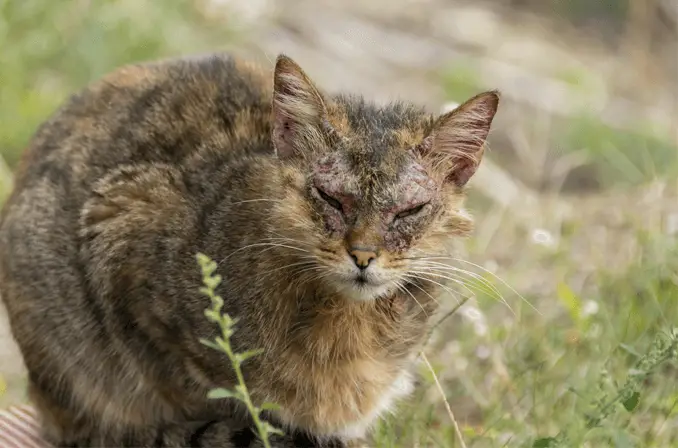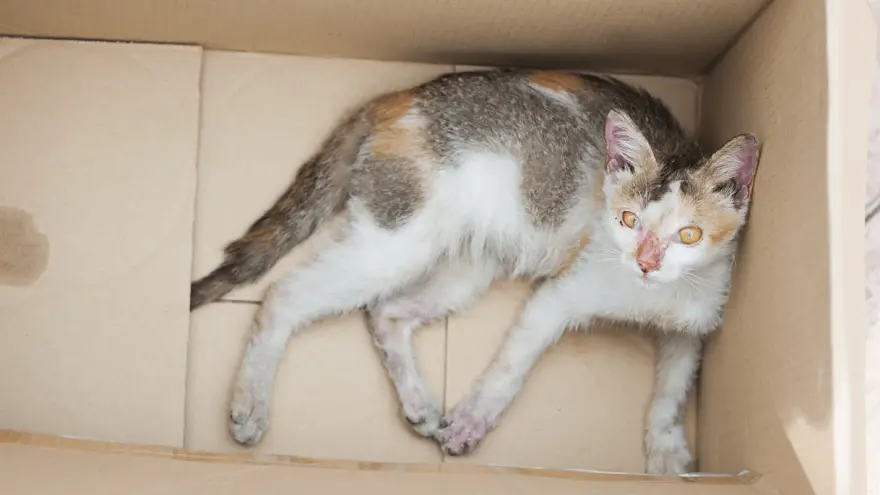Mange in Cats: Causes, Symptoms & Treatment
17.03.2022.
One of the most important tasks cat owners have is keeping their cats safe from various parasites. Parasites come in all shapes, forms, and sizes. Some are internal, and some are external. They carry different diseases, and one of the most common skin problems cats face is mange. If you have ever seen a touching cat rescue video where a cat appears very sick with terrible fur and skin, it was most likely a case of mange in cats. If you’re worried about your cat or you just want to know more about this issue, here’s all you need to know about mange in cats.
What Is Mange and How Does It Affect Your Cat?
Mites cause mange. These parasites may feed on ear wax or burrow into your cat's skin, depending on the type of mange mite, but no matter what they do to your cat, they all cause discomfort. Scabies, Demodex, ear mites, and walking dandruff are cats' most prevalent types of mange. Still, trombiculosis and fur mites are also issues cat owners need to be aware of. Mange can be defined as a skin condition (not a disease) caused by various types of mites. Here are some of the possible mange causes.
Scabies
Sarcoptes scabei (sarcoptic mange) or Notoedres cati (notoedric mange) mange mites produce scabies, which is very contagious. Although the Notoedres form is uncommon in healthy cats and the Sarcoptes type is more common in dogs, both can induce scabies in cats.
RELATED: How Often Should I Take My Cat to the Vet?
Demodicosis
Demodicosis is a term used to describe an infestation of Demodex mange mites in a cat or dog. Demodex cati and Demodex gatoi mites are both capable of causing demodicosis. D. cati is a natural inhabitant of a healthy cat's skin. However, in a sick cat with a compromised immune system, it can induce demodicosis. D. gatoi is a highly contagious Demodex type that is most commonly detected in young cats.
Ear Mites
As the name suggests, these mites live in cats' ears. Otodectes cynotis, often known as otodectic mange mites, are one of the most prevalent types of mange found in cats.
Walking Dandruff
Cheyletiella blakei are mange mites that create cheyletiellosis, or walking dandruff. These mites got their name from the appearance of "walking dandruff" when they walk around on a cat and move flakes of skin around the cat’s skin surface.
RELATED: Cat Dandruff: Causes & Treatment
Fur mites
Lynxacarus radovskyi is a type of fur mange mite that affects cats in several parts of the world. These mites can be found in cats in Australia, Brazil, Hawaii, Florida, North Carolina, and Texas.
Trombiculosis
Mange mites in the Trombiculidae family cause trombiculosis in cats. The larval stage of these mites, sometimes known as chiggers, clings to the skin and fur of cats, causing trombiculosis.
Because mange is an exterior parasite, symptoms can be observed on a cat's skin, ears, and fur.
RELATED: Ringworm in Cats | Symptoms, Diagnosis & Treatment
How Can I Know if My Cat has Mange?
Most cat owners will notice their cat is going through something uncomfortable. If you’re worried your cat might have health issues, especially mange, you should look for clinical signs. Most cat owners will notice increased itching, and the cat will seem restless because it cannot get comfortable. As soon as the cat lays down, the itching will make it move in a different position. Naturally, cats will get agitated and nervous. Mange is a skin condition, which means cat owners will notice changes such as crusting, bald spots, and hair loss.

Symptoms of Mange in Cats
Because the symptoms of many types of mange or mite infestations are similar to those of many other skin illnesses, a trip to the veterinarian for testing is often required. Nevertheless, cat owners will usually have no problem noticing mange symptoms. Here are the most common symptoms of mange in cats.
- Restlessness, the cat can't be comfortable because of the skin irritation
- Bouts of intense itching and scratching
- Excessive licking and grooming
- Patchy hair loss, especially around the ears and face that can spread to other parts of the body
- Swelling or bumps in affected areas
- Scaling in affected areas
Mange in Cats: How Is It Diagnosed?
A trip to the veterinarian will include skin scrapings from your cat's skin to be evaluated under a microscope in order to acquire the correct medicine for the specific mange-causing mite. A skin scraping test may not be conclusive since mites can burrow deeper under the skin. Other indicators, as well as a comprehensive physical examination and your cat's medical history, may be required by your veterinarian.
RELATED: 7 Helpful Cat Grooming Tips
How to Care for a Mange-Infected Cat
Treatment is necessary, but it can be distressing for a cat. They can be itchy, but they may also have to put up with bathing and being separated from other pets and people in the house. Most cat owners find that these measures are easier said than done because most cats have a natural dislike of water and have free reign of the house.
If your veterinarian instructs you to separate a cat with contagious mites during treatment, keep in mind that mites are highly contagious and rapidly transfer from animal to animal. The veterinarian may also send you home with topical treatment to apply on your cat's skin, an injection, and/or a specific, prescription-only cat shampoo, depending on your cat's health and the type of mange. A veterinarian may prescribe antibacterial shampoo, anti-inflammation drugs, pain-relieving sprays, or antibiotics to protect your cat from further infections and make her more comfortable since their skin is already sensitive.
Before using any over-the-counter insecticides or treatments, seek advice from your veterinarian. Not every insecticide, collar, or parasite-killing shampoo will work, and some aren't designed to be used on cats.
Is There a Way to Prevent Mange?
Bugs are, well, bugs. They show here, do their thing, and if you get rid of them, they're gone - as long as you don't get infected with them again elsewhere. Isolating an infectious cat from other animals until the mite infestation is resolved is the first step in treatment and prevention. Because some of these pests are spread by contact with wildlife, other cats, or exposure to the elements, keeping cats indoors can help avoid mange.
RELATED: 5 Best Flea Treatments For Cats: Vet Recommendations
Staying indoors and avoiding animals that run around outside are the next steps in preventing mites. To avoid further infestations, vets strongly advise following your vet’s suggestion for the appropriate parasite control medications at the prescribed frequency.
The good news about mange, as unpleasant, disgusting, and scary as it is, is that these mites and other topical parasites on your cat are only a temporary problem. Your cat can come back to living a relatively itch-free life with time, treatment, and veterinary guidance, and you can both safely enjoy each other’s company.
World Cat Finder Team







Share